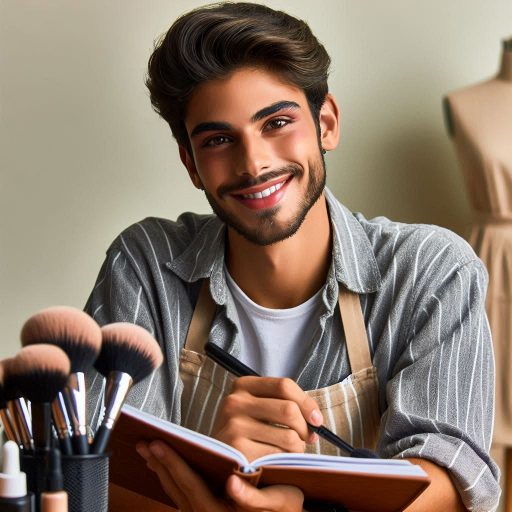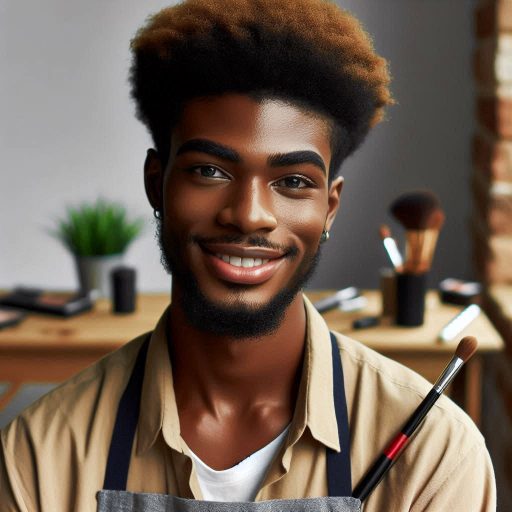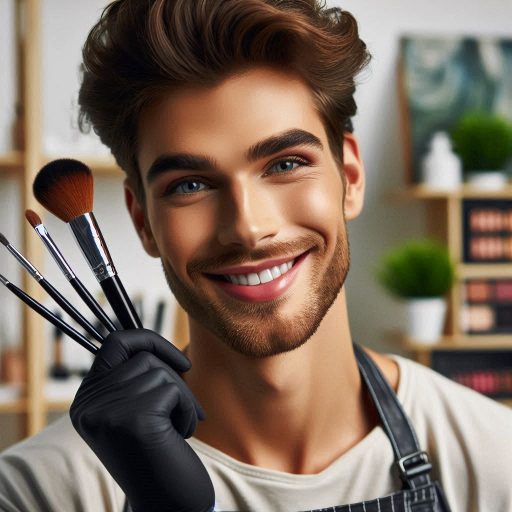Introduction
Styling models for photoshoots is a crucial element in achieving the desired aesthetic and look for the photos.
The impact of styling on the overall outcome of the photos cannot be underestimated.
From the choice of clothing, accessories, hair, and makeup, styling sets the tone and creates the mood for the photoshoot.
It helps convey a particular message or evoke a specific emotion.
Proper styling can elevate a basic photo to a stunning editorial spread, while poor styling can detract from the beauty of the model and the concept of the shoot.
Conducting a Pre-shoot Consultation
Importance of meeting with the team to plan the styling
Before diving into the actual photoshoot, it is essential to schedule a pre-shoot consultation with the team involved.
This meeting allows everyone to align on the styling direction, ensuring a cohesive outcome that meets the client’s expectations.
The need to understand the vision of the shoot and the client’s preferences
During the consultation, it is crucial to discuss the overall vision of the shoot.
Understanding the mood, theme, and objectives of the photoshoot will guide the styling decisions to create a harmonious look that resonates with the desired aesthetic.
Moreover, taking the time to listen to the client’s preferences is key.
Whether they have specific outfit ideas in mind or certain colors they prefer, incorporating these elements into the styling will ensure a personalized touch that reflects the client’s individual style.
Overall, a pre-shoot consultation lays the foundation for a successful photoshoot by establishing clear communication among the team, aligning on the styling direction, and incorporating the client’s vision and preferences into the overall planning process.
Read: Understanding Fashion Trends and How to Set Them
Choosing the Right Clothing
When it comes to styling models for photoshoots, choosing the right clothing is crucial.
Here are some tips to help you select the perfect outfits:
Tips for Selecting Clothing
- Consider the model’s body shape and size to ensure a proper fit.
- Choose clothing that complements the model’s features and enhances their best assets.
- Opt for solid colors or subtle patterns that won’t distract from the overall look.
- Avoid clothing with logos or busy prints that can clash with the background or other elements in the photo.
- Pay attention to fabric choices – lightweight fabrics like chiffon or silk can create beautiful movement in photos.
- Experiment with different textures to add depth and interest to the images.
Considering the Theme and Mood
- It’s important to think about the theme and mood of the photoshoot when selecting clothing.
- For a casual and relaxed shoot, opt for comfortable and easy-going outfits like jeans and t-shirts.
- For a more formal or elegant look, consider tailored pieces like suits or dresses.
- Think about the color palette – choose colors that complement the setting and overall vibe of the shoot.
- Accessories can also play a key role in enhancing the theme – think about adding hats, scarves, or jewelry to complete the look.
- Don’t forget about shoes – the right footwear can tie the whole outfit together and add a finishing touch to the photos.
By following these tips and considering the theme and mood of the shoot, you can ensure that your models look their best and that the photos turn out beautifully.
Read: Innovative Makeup Products to Watch in 2024
Paying Attention to Accessories
Impact of accessories on the overall look of the model
Accessories play a crucial role in defining the overall look of a model during a photoshoot.
They can either enhance or detract from the outfit, so it’s vital to choose them carefully.
A well-chosen accessory adds a touch of sophistication and completes the look, making it more cohesive and polished.
Transform Your Career Today
Unlock a personalized career strategy that drives real results. Get tailored advice and a roadmap designed just for you.
Start NowThe impact of accessories on the overall appearance of the model cannot be underestimated.
They can transform a simple outfit into something striking and memorable.
For instance, a statement necklace can draw attention to the neckline and face, while a stylish belt can accentuate the waistline.
However, overdoing it can overshadow the outfit and distract from the model’s natural beauty.
Selecting accessories that complement the outfit without overpowering it
To ensure accessories complement the outfit without overpowering it, consider the following tips.
First, balance is key. If the outfit is bold and colorful, opt for subtle accessories.
Conversely, if the outfit is simple, you can afford to be more adventurous with your accessory choices.
Second, keep the outfit’s style in mind.
Match the accessories to the overall theme and vibe of the outfit, whether it’s casual, formal, or avant-garde.
Also, pay attention to proportions.
Large, dramatic accessories can work well with minimalist outfits but might overwhelm more detailed or busy ensembles.
Ensure that the size and scale of the accessories harmonize with the outfit and the model‘s physique.
Finally, don‘t forget the context of the photoshoot.
The setting and purpose of the shoot should guide your accessory choices.
Accessories should enhance the look without stealing the spotlight from the model or the outfit.
By carefully selecting and coordinating accessories, you can elevate the overall look and create a more impactful and visually appealing photoshoot.
Hair and Makeup
Significance of hair and makeup in styling models
Hair and makeup are crucial elements in styling models for photoshoots.
They play a significant role in defining the overall look and enhancing the model‘s appearance.
Effective styling can make or break a photoshoot.
Showcase Your Business Today
Reach thousands of readers actively exploring professional services. Publish your business profile and grow your audience now.
Publish NowFirst, hair and makeup should align with the shoot‘s theme and style.
A cohesive look helps convey the intended message and mood.
For instance, a vintage shoot requires classic hairstyles and makeup, while a modern shoot might call for sleek, minimalist styles.
Tips on coordinating hair and makeup with the overall look of the shoot
When planning hair and makeup, consider the model’s features and the photographer‘s vision.
Consult with the photographer to ensure your choices complement the overall concept.
For example, bold makeup might be necessary for high-fashion shoots, while natural looks suit commercial shoots.
Hair should be styled to suit the shoot‘s theme and the model‘s attire.
Ensure that the hairstyle enhances the outfit and overall look.
Avoid styles that compete with the clothing or distract from the model’s face.
Simple, elegant hairstyles often work well for most shoots, but be ready to adapt based on the theme.
Makeup should be applied with precision, taking into account the lighting conditions of the shoot.
Different lighting can alter how makeup appears on camera.
Use high-quality products to ensure that makeup looks flawless in photos.
Test makeup under similar lighting to what will be used during the shoot.
Additionally, coordinate the makeup with the model’s hair.
Ensure that the colors and styles complement each other.
For example, if the model has bold eye makeup, keep the lip color balanced to avoid overpowering the look.
Basically, hair and makeup are essential in styling models for photoshoots.
They should be tailored to fit the theme and enhance the overall visual impact.
Effective coordination can elevate the quality of the shoot and ensure a polished final product.
Read: Top Influential Designers in the American Fashion Scene

Consideration for Body Types
Importance of understanding each model’s body type
When styling models for photoshoots, it’s essential to consider their body types to enhance their best features.
Before styling a model, take the time to understand their body type.
This will help you choose the right outfits and poses that flatter their unique features.
Advice on Styling Different Body Types
Hourglass Shape
For models with an hourglass shape, emphasize their waist by opting for fitted clothing that accentuates their curves.
A-line dresses and high-waisted bottoms work well for this body type.
Pear Shape
If a model has a pear-shaped body, draw attention to their upper body with statement tops and bold accessories.
A-line skirts and wide-leg pants can create balance by adding volume to the lower half.
Rectangle Shape
To create curves for models with a rectangle shape, consider using belts or cinched waistlines to define their waist.
Layering outfits with textures and patterns can also add dimension to their figure.
Apple Shape
For models with an apple shape, focus on elongating their silhouette by opting for V-necklines and empire waist tops.
Flowy tops and dresses that skim over the midsection can help create a flattering look.
Inverted Triangle Shape
If a model has an inverted triangle shape, balance their broad shoulders with outfits that draw attention to their lower body.
Wrap tops, flared bottoms, and asymmetrical hemlines can help create a more proportionate silhouette.
Petite Frame
When styling models with a petite frame, choose clothes that elongate their figure, such as high-waisted bottoms and vertical stripes.
Tailored pieces that fit well and avoid overwhelming their smaller frame are key.
Tall and Slender
For models who are tall and slender, embrace their height by opting for long silhouettes and flowy fabrics.
Structured pieces can also add definition to their frame without overpowering their natural height.
By considering each model’s body type and styling them accordingly, you can showcase their best features and create stunning photographs.
Remember, confidence is the best accessory any model can wear!
Showcase Your Business Today
Reach thousands of readers actively exploring professional services. Publish your business profile and grow your audience now.
Publish NowRead: Behind the Scenes: A Day in the Life of a Makeup Artist
Delve into the Subject: Essential Tools for UX/UI Designers: A Complete List
Incorporating Trends
Staying current with fashion trends is crucial for a successful photoshoot.
Incorporating trends into styling adds a fresh and modern touch to the overall look.
However, it’s important not to go overboard and become too trendy.
Importance of Staying Current
By staying current with trends, you show that you are aware of what’s happening in the industry.
It also helps your photoshoots feel relevant and up-to-date.
Clients and audiences appreciate seeing models styled in trendy looks.
Suggestions for Incorporating Trends
Start by researching the latest trends in fashion magazines, blogs, and social media.
Look for key pieces or elements that can be incorporated into the styling.
Consider adding trendy accessories, such as statement jewelry or bold shoes.
Mix trendy pieces with classic wardrobe staples for a balanced look.
Experiment with different trends to see what works best for the photoshoot.
Remember that trends come and go, so choose ones that align with the overall theme and aesthetic.
Don’t force trends into the styling if they don’t fit the model’s vibe or the concept of the shoot.
Focus on timeless styles that have a touch of trendiness rather than going all out with the latest fads.
Ultimately, the goal is to enhance the model’s natural beauty and personality while staying current with fashion trends.
Creating a Mood Board
A mood board helps set the tone and visual direction for the photoshoot.
It allows everyone involved to be on the same page regarding the overall aesthetic.
Gathering inspiration from various sources can spark creativity and generate fresh ideas.
Having a mood board minimizes misunderstandings and ensures a cohesive look for the shoot.
Benefits of Creating a Mood Board
- Visual Inspiration: Images, color palettes, and textures on the mood board inspire styling choices.
- Communication Tool: It facilitates effective communication among the team, including stylists, photographers, and models.
- Consistency: By referencing the mood board, you can maintain a consistent look across different shots.
- Focus and Direction: Helps in focusing on the key elements and provides a clear direction for the shoot.
Advice on How to Use a Mood Board
- Do Proper Research: Collect images, color schemes, and textures that resonate with the shoot’s theme.
- Organize and Curate: Arrange the mood board in a visually appealing manner to convey the desired mood.
- Seek Feedback: Share the mood board with the team to gather feedback and ensure everyone understands the vision.
- Refer to It Often: During the shoot, refer back to the mood board to stay true to the planned aesthetic.
Creating a mood board is a crucial step in styling models for photoshoots.
It not only helps in setting the right mood and tone for the shoot but also ensures everyone is aligned on the creative direction.
By utilizing a mood board effectively, you can bring your vision to life and produce stunning visual content.
Conclusion
Styling models for photoshoots requires attention to detail and proper planning.
By following these best practices, you can ensure that your photoshoots are successful and produce stunning results.
Remember to consider the overall theme and concept of the shoot, choose the right outfits and accessories, pay attention to hair and makeup, and communicate effectively with your team.
By focusing on these key points, you can elevate the overall look of your photoshoot and create visually appealing images that stand out.
Don’t be afraid to experiment and try new things to find what works best for you.
Encourage readers to apply these best practices in their own photoshoot styling to achieve better results.
With practice and perseverance, you can develop your own unique style and create beautiful imagery that leaves a lasting impression.
[E-Books for Sale]
The Big Book of 500 High-Paying Jobs in America: Unlock Your Earning Potential
$19.99 • 500 High-Paying Jobs • 330 pages
Explore 500 high-paying jobs in America and learn how to boost your career, earn more, and achieve success!
See All 500 High-Paying Jobs of this E-Book
1001 Professions Without a Degree: High-Paying American Jobs You Can Start Now
$19.99 • 1001 Professions Without a Degree • 174 pages
Discover 1001 high-paying jobs without a degree! Unlock career tips, skills, and success strategies for just $19.99!




